HuntOps
3/6/2020 - Trickbot
- Packets
- Getting Data into ROCK
- Trickbot information stealer background
- gtag information stealer background
We’ve done a Trickbot analysis before, but when I started poking around on this one, I found some indicators that weren’t being detected by Suricata and in pulling that thread, found indicators that hadn’t been previously reported anywhere, to include the binaries that I’ve carved from PCAP. By the publish date, there could be others who’ve found this, but as I’m starting this post (3/3/20), these haven’t been identified elsewhere.
Note: I changed the way I replayed my traffic this time by removing the -t flag from tcpreplay. While this takes much longer (2 1/2 hours in this specific case), but it makes for a better view of the event pattern of life.
Let’s start with the known knowns - Suricata.
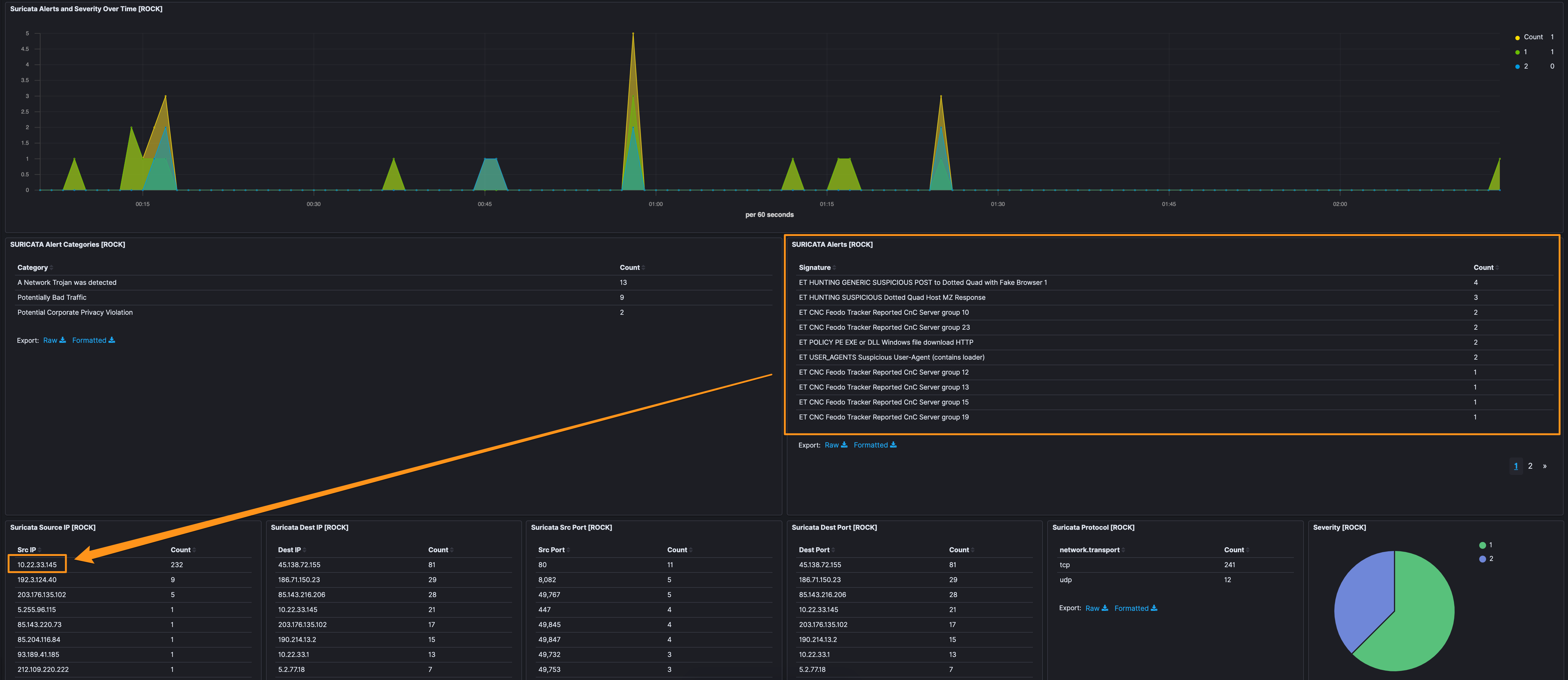
Note: Curl, myexternalip[.]com, and ipecho[.]net are called out by Suricata, we know they’re bad because these PCAPs are bad and we’ve seen them used in other Trickbot infections, but we’re not going to sandbag and add them as “known bad” unless we can connect it to malicious traffic.
Walking through the image, we have ET HUNTING GENERIC SUSPICIOUS POST to Dotted Quad with Fake Browser 1 as the highest. This signature is seen with a lot of trojans and is more of an “this event could be interesting” vs. a smoking gun. Applying this alert as a filter, we see the host 10.22.33.145 is the source - which we can see (with no filters) makes up for 232 events, so I’m going to lean to say 10.22.33.145 is a good host to focus on.
The next alert is ET CNC Feodo Tracker Reported CnC Server group x, there are several of those for different “groups”. Filtering on them individually, it’s also 10.22.33.145 as the infected host. With the volume here, I’m going to pop over and make a simple data table with destination.ip, source.ip, and alert.signature.
Of note, there are 4 ports involved here, 447 and 449 (both TLS) look pretty uniform across the alerts, but 443 and 8082, while hitting the same signature, appear to be different stages in the event, so we’ll take note of those and poke at those later.
| Destination IP | Source IP | Signature | Tag |
|---|---|---|---|
| 186[.]71[.]150[.]23 | 10.22.33.145 | ET CNC Feodo Tracker Reported CnC Server group 10 | Banking_Trojan |
| 190[.]214[.]13[.]2 | 10.22.33.145 | ET CNC Feodo Tracker Reported CnC Server group 12 | Banking_Trojan |
| 195[.]133[.]145[.]31 | 10.22.33.145 | ET CNC Feodo Tracker Reported CnC Server group 13 | Banking_Trojan |
| 5[.]2[.]77[.]18 | 10.22.33.145 | ET CNC Feodo Tracker Reported CnC Server group 19 | Banking_Trojan |
| 85[.]143[.]216[.]206 | 10.22.33.145 | ET CNC Feodo Tracker Reported CnC Server group 23 | Banking_Trojan |
| 66[.]85[.]173[.]20 | 10.22.33.145 | ET CNC Feodo Tracker Reported CnC Server group 20 | Banking_Trojan |
| 93[.]189[.]41[.]185 | 10.22.33.145 | ET CNC Feodo Tracker Reported CnC Server group 25 | Banking_Trojan |
| 203[.]176[.]135[.]102 | 10.22.33.145 | ET CNC Feodo Tracker Reported CnC Server group 15 | Banking_Trojan |
Eliminating those Feodo Tracker hits, what else is Suricata telling us?
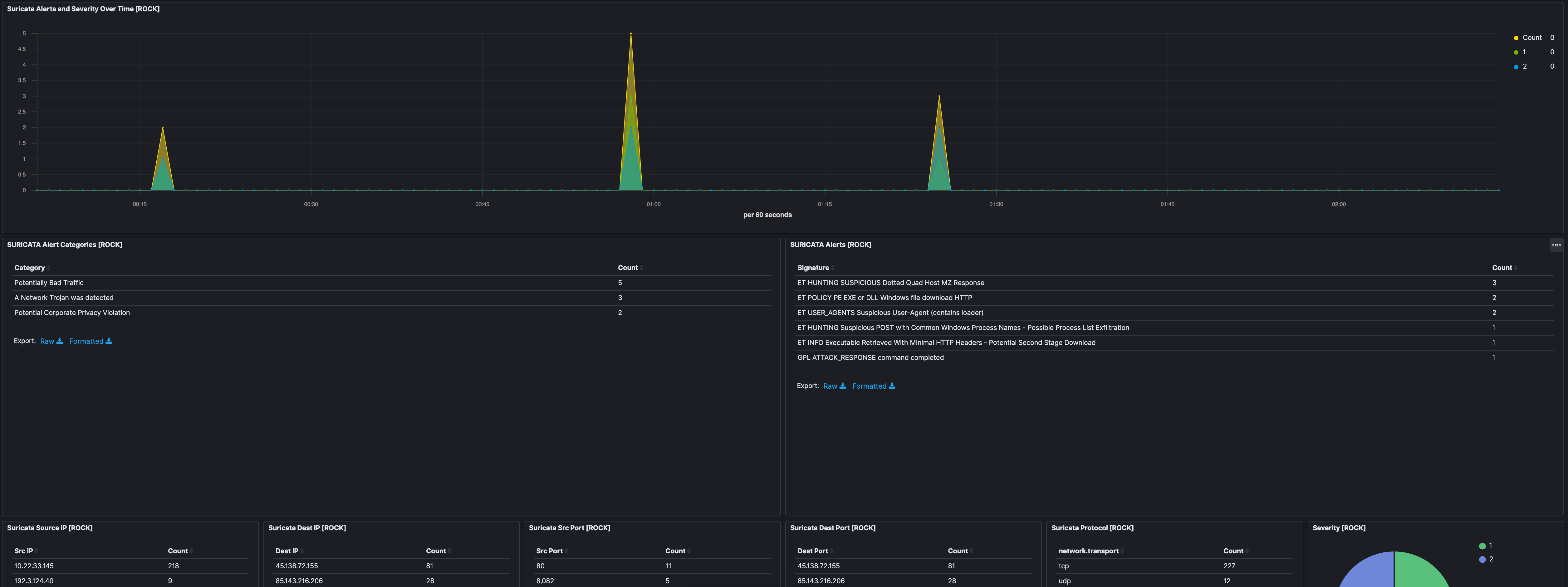
In filtering out the above Feodo signatures, there was 1 other IP address that we’d not identified previously as well as the one that used port 8082 (192[.]3[.]124[.]40 and 203[.]176[.]135[.]102, respectfully). Additionally, there was some high-port to high-port communication coming from 192[.]3[.]124[.]40, which is interesting.

Let’s get out of the “known bad” identified by signatures, and go over to the Discover tab to see what else we can find out about the traffic. Let’s start with Zeek data and just those 2 IP addresses
event.module: zeek AND (source.ip: 192[.]3[.]124[.]40 OR destination.ip: 192[.]3[.]124[.]40 OR source.ip: 203[.]176[.]135[.]102 OR destination.ip: 203[.]176[.]135[.]102)
When we organize the data this way, we can see 2 connection groups that look the most interesting:
| Source IP | Destination IP | Interesting Item |
|---|---|---|
| 10.22.33.145 | 203[.]176[.]135[.]102 | Suricata hits w/port 8082 |
| 10.22.33.145 | 192[.]3[.]124[.]40 | Suricata hits w/PE downloads |
I’ll target the unencrypted traffic and pull some packets out and do some analysis.
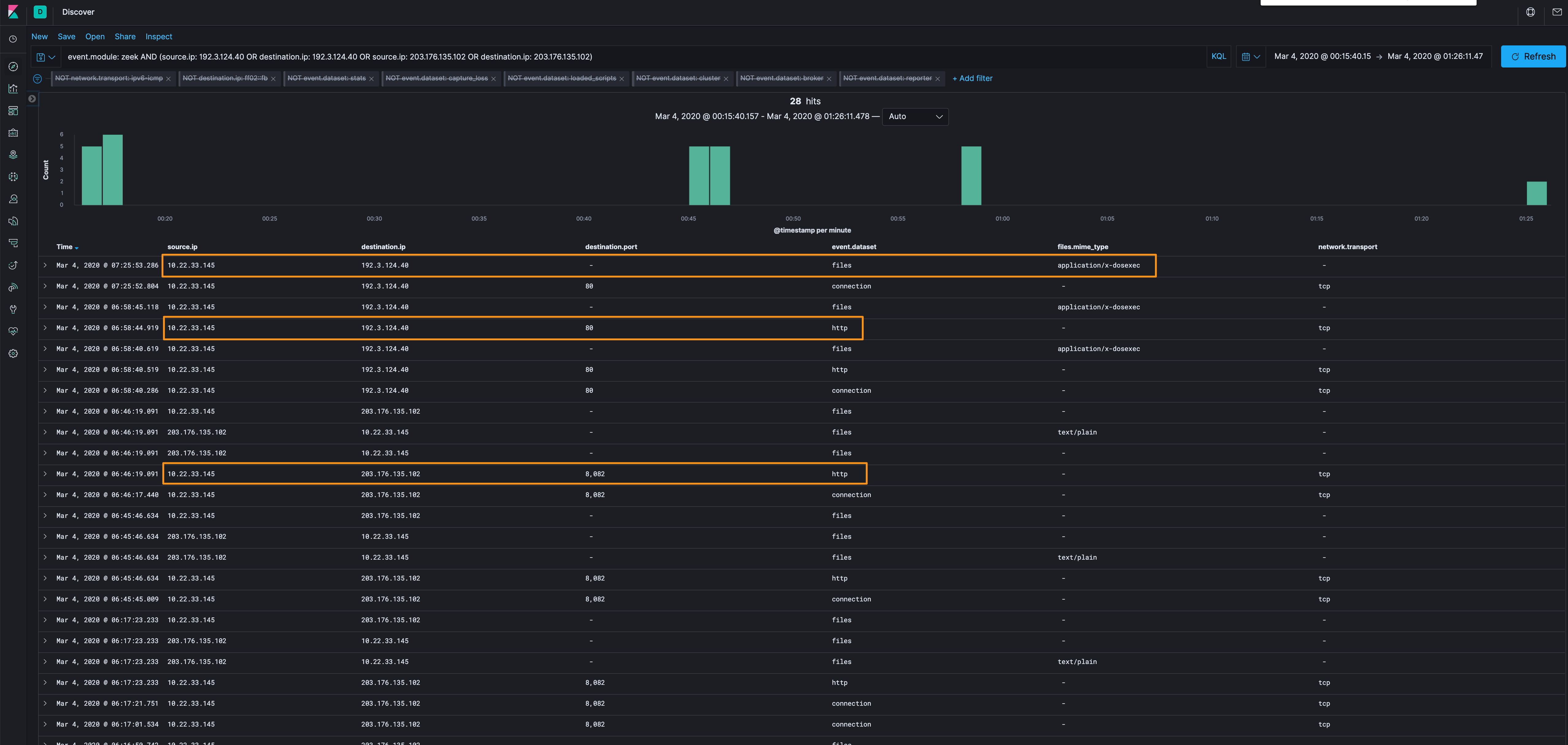
Let’s start with the PE downloads. There are 2 ways to collect them:
- Carve from PCAP w/Docket
- Leverage the file extraction feature of Zeek.
These have names that we’ve seen in my previous analysis of Trickbot, (mini[.]png, lastimage[.]png x2). Of note, these samples are not in VirusTotal as of 3/3/2020. Their hashes are in the Artifacts section as well as Yara signatures in the Detection Logic. This looks to be Trickbot traffic.
Moving onto 203[.]176[.]135[.]102.
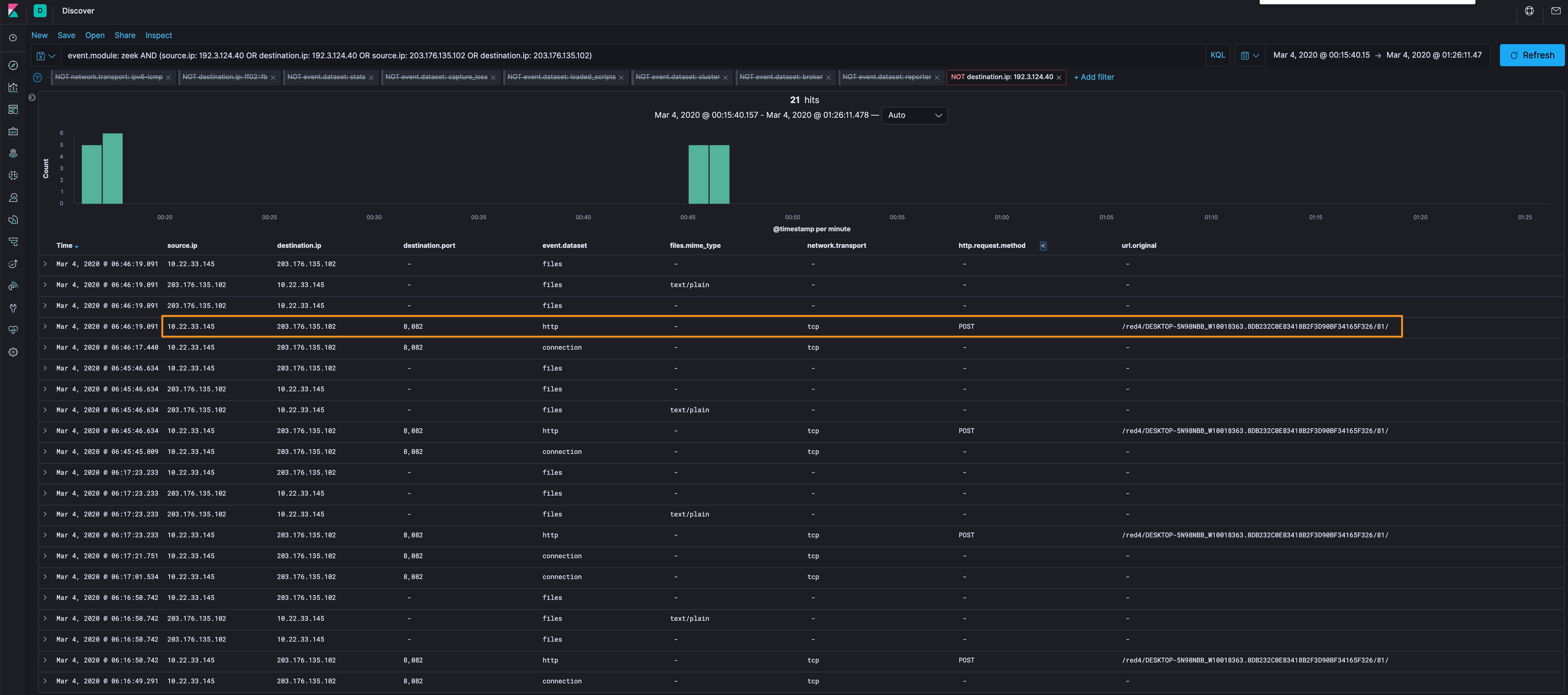
We can see that the HTTP POST connections appear to be uploading some data /red4/DESKTOP-5N98NBB_W10018363.8DB232C0E83418B2F3D90BF34165F326/81/ and /red4/DESKTOP-5N98NBB_W10018363.8DB232C0E83418B2F3D90BF34165F326/90 (/90 is provided by Suricata logs, not Zeek). This looks like host identification information to a server named Cowboy (which we’d also seen in our previous Trickbot analysis).

Looking at all of this traffic, it looks like the hash values and infrastructure have been changed from previous intrusions, but not the TTPs used by the aggressor.
Let’s look back at some of the 447 and 449 traffic we identified earlier and see if there are any IPs that we didn’t catch with Suricata…and 3 new IPs that didn’t trip a Suricata alert.
- 170[.]84[.]78[.]224
- 212[.]109[.]220[.]222
- 85[.]204[.]116[.]84

Looking at them in Discover, there are a lot of failed connections (RSTO/R - aborted by the originator/responder and S0 a connection attempt seen, but no reply), so let’s add that to the data table and see. Here we’ve got a new IP.
- 5[.]255[.]96[.]115

Note: Having reset or failed connection attempts isn’t necessarily a guaranteed bad, but when we’re seeing the same traffic profile (port 447, 449, high-port to high-port) in conjunction with the resets…and some OSINT research also associates them with Trickbot, I’m going to categorize this as “bad”.
There’s been a lot here, so to round out, I decided to look through the TLS logs to see what we can see. As with all of this, it’s a bit of looking for needles in a needle stack, but the process is the same.

We can see that there is some SSL Subjects that certainly look suspect. When we look at some of the IP addresses, we can see that they’re from known bad actors (ex: 85[.]143[.]216[.]206).
| Source IP | Destination IP | Interesting Item |
|---|---|---|
| 10.22.33.145 | 85[.]143[.]216[.]206 | CN=example.com |
| 10.22.33.145 | 5[.]2[.]77[.]18 | CN=example.com |
| 10.22.33.145 | 66[.]85[.]173[.]20 | CN=example.com |
| 10.22.33.145 | 5[.]2[.]77[.]18 | CN=vps31656725 |
| 10.22.33.145 | 186[.]71[.]150[.]23 | ST=Some-State |
| 10.22.33.145 | 190[.]214[.]13[.]2 | ST=Some-State |
| 10.22.33.145 | 5[.]182[.]210[.]226 | CN=img[.]bullforyou[.]com |
Of extreme note, are 5[.]182[.]210[.]226 and CN=img[.]bullforyou[.]com. These are new indicators and in searching them online, I wasn’t able to find much research (as of 3/3). In digging into the certificate analysis, you can see that this domain had several subdomains for multiple states. In doing some additional research, this shows up just 2 times (ex: 1, 2), but even though this is in bad PCAP, I’m going to put this into the “bad” category as I really feel like this is C2. If anyone has other observations or opinions, I’d love to hear them.
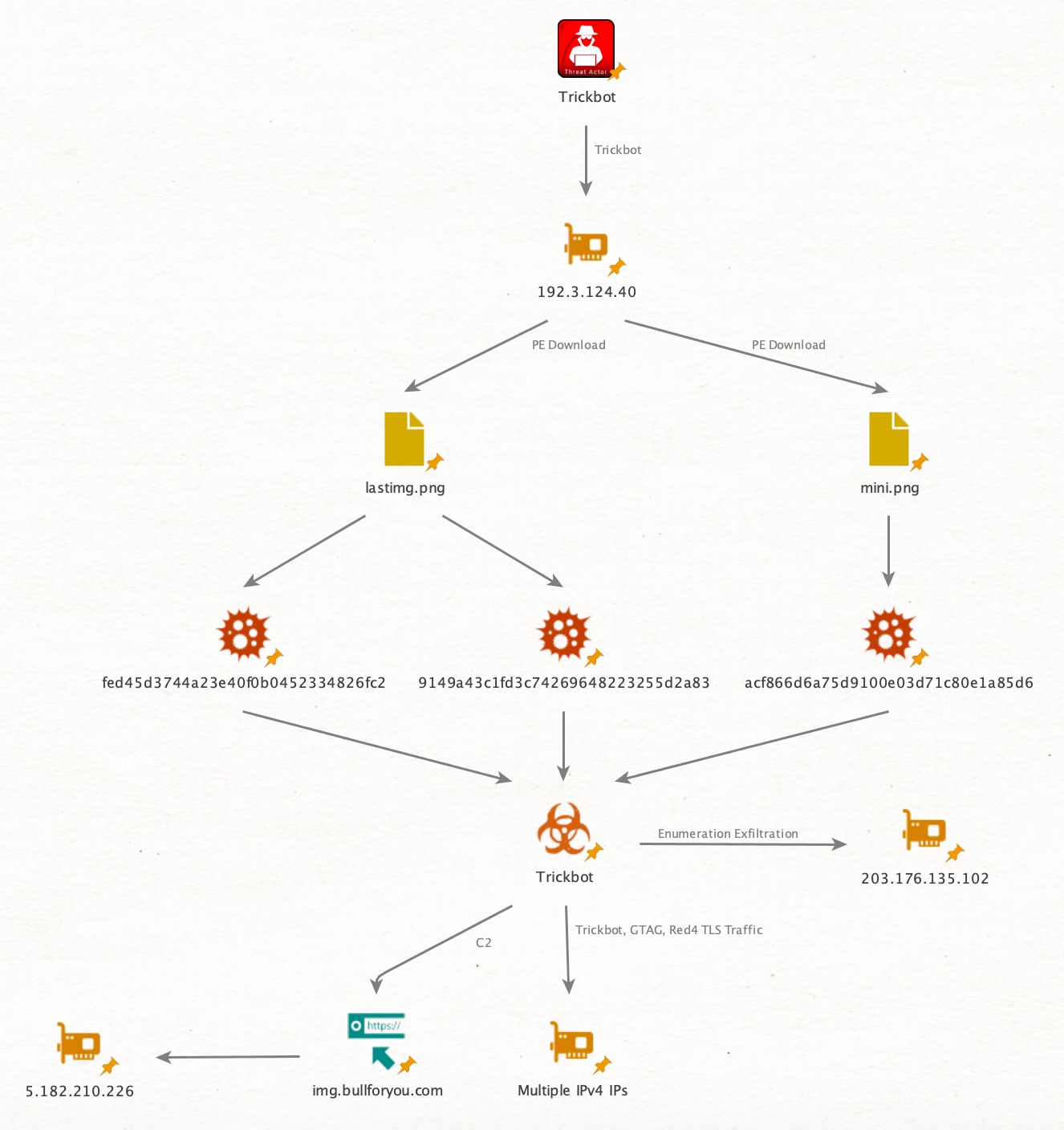
Detection Logic
Additional analysis, modeling, and signatures (KQL and Yara).
Artifacts
5[.]2[.]77[.]18 port 447 (Trickbot, GTAG, Red4 TLS traffic)
5[.]255[.]96[.]115 port 443 (Trickbot, GTAG, Red4 TLS traffic)
85[.]143[.]216[.]206 port 447 (Trickbot, GTAG, Red4 TLS traffic)
85[.]143[.]220[.]73 port 447 (Trickbot, GTAG, Red4 TLS traffic)
186[.]71[.]150[.]23 port 449 (Trickbot, GTAG, Red4 TLS traffic)
190[.]214[.]13[.]2 port 449 (Trickbot, GTAG, Red4 TLS traffic)
195[.]133[.]145[.]31 port 443 (Trickbot, GTAG, Red4 TLS traffic)
66[.]85[.]173[.]20 port 447 (Trickbot, GTAG, Red4 TLS traffic)
93[.]189[.]41[.]185 port 447 (Trickbot, GTAG, Red4 TLS traffic)
203[.]176[.]135[.]102 port 8082 (enumeration data exfil)
192[.]3[.]124[.]40 (port 80, 50063, and 49767 Trickbot PE download)
170[.]84[.]78[.]224 port 449 (Trickbot, GTAG, Red4 TLS traffic)
212[.]109[.]220[.]222 port 447 (Trickbot, GTAG, Red4 TLS traffic)
85[.]204[.]116[.]84 port 447 (Trickbot, GTAG, Red4 TLS traffic)
5[.]182[.]210[.]226 (Trickbot C2, moderate confidence)
img[.]bullforyou[.]com (Trickbot C2, moderate confidence)
9149a43c1fd3c74269648223255d2a83 - lastimage[.]png (Trickbot binaries)
fed45d3744a23e40f0b0452334826fc2 - lastimage[.]png (Trickbot binaries)
acf866d6a75d9100e03d71c80e1a85d6 - mini[.]png (Trickbot binaries)
Until next time, cheers and happy hunting!